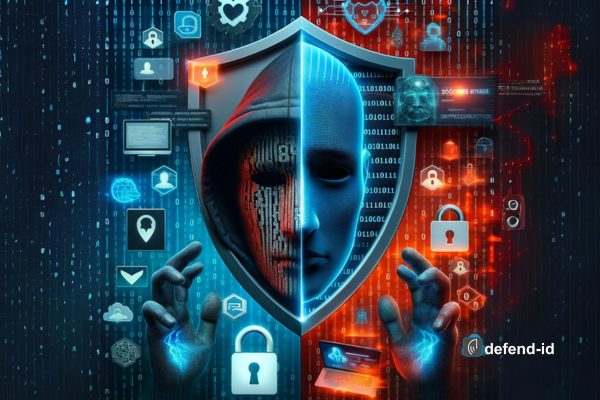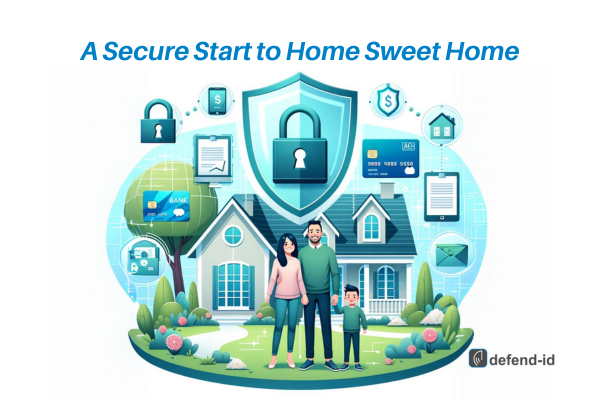
by Brian Thompson | Nov 30, 2023 | Uncategorized
The Medicare enrollment period marks not only a crucial time for seniors but also a phase of heightened risk of identity theft in this demographic. With identity thieves increasingly targeting this age group, comprehending these unique risks is crucial for effective prevention. In this blog post, we explore the heightened risk of identity theft in seniors, particularly during the Medicare enrollment period, offering strategic insights and tips to counter this growing concern.
Senior Identity Theft Protection During Medicare Enrollment
Targeted for Their Vulnerability
- Seniors are often perceived as more vulnerable due to substantial savings and potential unfamiliarity with digital security measures.
- The Federal Trade Commission (FTC) finds that individuals over 60 are less likely to report fraud, which can encourage identity thieves.
Alarming Statistics:
- According to the Department of Justice, seniors are 34% more likely to fall victim to identity theft than younger people.
- The average loss for seniors from identity theft is around $1,200, significantly higher than the amount lost by younger victims, per recent studies.
Essential Tips for Protecting Your Identity During Medicare Enrollment
- Medicare Number Safety: Treat your Medicare number with the same confidentiality as a credit card number.
- Awareness of Medicare Scams: Remember, official Medicare representatives will not call to ask for your number unless you’ve previously agreed to such contact.
- Vigilance with Medicare Statements: Regularly review your statements for any discrepancies.
- Document Security: Dispose of sensitive documents, like old Medicare statements, by shredding.
- Skepticism of ‘Free’ Offers: Be wary of offers asking for your Medicare number in exchange for free services.
Steps to Take if Identity Theft Occurs
- Report Immediately: Contact Medicare at the first sign of fraud, especially during this high-risk period.
- Monitor Your Credit: Regularly review your credit reports for unfamiliar activities.
- Notify Healthcare Providers: Keep your medical records accurate by informing providers of any identity theft incidents.
Senior Identity Theft Protection During Medicare Enrollment
As the Medicare enrollment period progresses, it’s more important than ever for seniors to be equipped with knowledge and strategies to protect themselves from identity theft. Understanding the risks, regularly monitoring personal and financial information, and practicing caution can significantly reduce the likelihood of becoming a victim. Stay informed, stay vigilant, and protect your well-being during this crucial time.
Articles Related to 2023 Medicare Enrollment: Essential Tips for Senior Identity Theft Prevention:

by Brian Thompson | Nov 15, 2023 | Identity Theft
The excitement of Black Friday is just around the corner, and while it’s a great time to score amazing deals, it’s also a time when cybercriminals are particularly active, preying on unsuspecting shoppers. This comprehensive guide will equip you with the knowledge and tools to safeguard your personal information and enjoy a secure Black Friday shopping experience. B
1. Beware of Phishing Scams: Identify and Avoid Malicious Emails
Phishing scams are a common tactic used to trick unsuspecting individuals into revealing sensitive information, such as passwords, credit card details, or Social Security numbers. These emails often masquerade as legitimate communications from well-known companies or organizations, making them difficult to spot.
Here are some red flags to watch out for to identify phishing scams:
-
Account Verification Scams: Emails claiming a need to update your account information due to a hacking attempt or other security breach are likely phishing attempts. Genuine companies will never ask for sensitive details via email.
-
Order Confirmation and Billing Error Scams: Be cautious of emails about unexplained orders or billing issues. These emails often lead to fraudulent sites designed to steal your credit card information.
-
Delivery Scams: Ignore texts or emails with fake delivery notices or tracking numbers. These scams aim to lure you into clicking on malicious links or downloading malware.
2. Spotting Legitimate Deals: Exercise Caution and Verify Authenticity
In the frenzy of Black Friday sales, it’s easy to fall prey to scams. Here are some tips to spot genuine deals and avoid fraudulent ones:
-
Too Good To Be True: If a deal appears unrealistically low, it probably is. Exercise caution and verify the deal’s authenticity by checking the retailer’s official website or contacting their customer service team.
-
Personal Information Requests: Genuine companies will never ask for sensitive details, such as passwords or credit card information, through insecure means like email. If you receive such a request, it’s a clear indication of a scam.
-
Website Security: Ensure the website you’re shopping on uses encrypted connections, indicated by “https://” and a padlock symbol in the address bar. This ensures that your data is transmitted securely and protected from eavesdropping.
3. Utilizing Trusted Security Tools: Fortify Your Online Defense
Technology can be a powerful ally in safeguarding your identity online. Here are some essential security tools to consider incorporating into your online shopping routine:
-
Strong Security Software: Opt for reputable antivirus and anti-malware software to protect your device from malicious software and ransomware. Keep your software up to date to ensure the latest protection against evolving threats.
-
Virtual Private Networks (VPNs): Hide your IP address and location for secure browsing and prevent cyber criminals from tracking your online activity. This is especially useful when using public Wi-Fi networks, which are often unsecured.
-
Password Managers: Use tools that help you create and manage strong, unique passwords for each online account. Never reuse passwords across different sites, as this makes you more vulnerable to credential-stuffing attacks.
-
Ad Blockers: Employ ad blockers to avoid malicious pop-ups, scripts, and third-party tracking cookies. These can not only be annoying but can also potentially expose you to malware or redirect you to fraudulent sites.
-
Mobile Security Apps: Protect your smartphone from phishing sites and ensure secure online transactions, especially when shopping on the go. Many mobile security apps offer real-time protection and can block suspicious websites or prevent malicious downloads.
4. Immediate Actions if Compromised: Swift Response to Protect Your Identity
If you suspect your identity has been compromised, take immediate action to minimize the potential damage and protect your financial accounts:
-
Contact Your Bank: Immediately report any unauthorized transactions on your bank accounts or credit cards to prevent further losses. This will also allow your bank to take steps to protect your account and investigate the fraudulent activity.
-
Report to Authorities: Notify fraud reporting centers and law enforcement, especially if you believe your identity has been stolen for fraudulent purposes. This will help in tracking down the perpetrators and preventing future scams.
Stay Vigilant and Shop Securely
Black Friday is an excellent opportunity to find amazing deals, but it’s also a prime target for cybercriminals. By staying alert, employing these strategies, and utilizing the right security tools, you can enjoy the shopping spree without compromising your identity. Remember, the key to safe shopping is vigilance, caution, and the right use of technology.
Related Articles:

by Brian Thompson | Nov 10, 2023 | Identity Theft
As someone who holds our military community in high esteem, I’ve been reflecting on a critical issue we face- identity theft. This isn’t just a civilian problem—it’s a significant concern for our active duty personnel, veterans, and their families. Our national heroes are trained to be battle-ready for any threat to national security. Yet, there’s a front that often gets overlooked – Securing the Home Front: Identity Theft in the Military
Understanding the Risks
A surprising reality: Did you know that as military members, we’re at a heightened risk for identity theft? Reports suggest that nearly 50,000 military consumers have faced this challenge head-on. And it’s not just about the numbers; the consequences of stolen identity can ripple through our lives, causing financial and personal turmoil.
The Vulnerability of Our Forces
- Relocations and Deployments: Our service often requires us to pack up and move, sometimes at a moment’s notice. Each move is an opportunity for personal information to fall into the wrong hands, especially when we’re stationed overseas and focused on the mission at hand.
- A Culture of Trust: We rely on a shared bond of trust, a cornerstone of military cohesion. Unfortunately, scammers exploit this trust, posing as fellow service members or veterans to phish for sensitive information.
How to Fortify Your Defenses
We’re no strangers to defense strategies, but the tactics differ when it’s about protecting our identities:
- Shredding documents: Before you toss out those orders or reports, shred them. It’s your first line of defense.
- Credit monitoring: Make it a routine – check your credit reports regularly, just as you would maintain your gear.
- Vigilance with personal info: Train yourself to detect scams. If someone asks for personal information over the phone or email, verify their credentials first.
- Strong password protocols: Create passwords as robust as a fortified base. No simple ‘password123’ for us, right?
- Active duty alerts: Just like setting a perimeter, these alerts put a barrier between your credit and potential fraudsters while you serve.
Implementing Active Duty Alerts
Protecting your credit with active duty alerts is akin to having a watch guard for your finances. Here’s how to set it:
- Reach out to one of the three major credit bureaus – Equifax, Experian, or TransUnion. It’s like choosing which guard post to fortify.
- Confirm your identity with solid proof. This process is as essential as verifying clearance for a secured area.
- Initiate the alert, which signals the bureaus to step up their guard and verify any credit requests in your name carefully.
- Renew as required: Just like renewing your duty station orders, keep the alert active to match the length of your deployment.
Your Call to Action
Your financial safety is part of operational security. By staying vigilant, you protect not just yourself but also the integrity of our forces. Keep your personal information locked down, stay alert for signs of breaches, and spread the word. We’re in this fight together – let’s make sure we’re all armed and ready.
Identity theft in the military is prevalent…Stay safe and secure, both on and off the field.
Related Articles:

by Brian Thompson | Nov 8, 2023 | Identity Theft
In today’s hyperconnected world, technology has become an indispensable part of our lives, seamlessly weaving its way into our daily routines. From online banking and shopping to social media interactions and entertainment, technology has revolutionized the way we communicate, work, and engage with the world around us. However, this interconnectedness also brings with it a heightened risk to our personal information, making us vulnerable to identity theft. Identity theft protection in the digital age is something we all should be aware of.
The Double-Edged Sword of Technology: A Balancing Act of Protection and Exposure
Technology plays a dual role in our identity protection: it both shields and exposes our personal information. On the one hand, secure online banking platforms, encrypted communication channels, and password authentication mechanisms help safeguard our financial and sensitive data. Social media platforms, while not entirely secure, allow us to connect with friends and family, share experiences, and stay informed.
However, this same technology can also be exploited by cybercriminals to steal our identities. Phishing scams, malicious software, and data breaches are just a few examples of how criminals capitalize on the convenience and ubiquity of technology to infiltrate our digital lives.
The Evolving Landscape of Identity Theft: Staying Ahead of the Curve
 The methods used by identity thieves are constantly evolving, adapting to advancements in technology and our changing online habits. Phishing scams, once relying on deceptive emails, have become more sophisticated, impersonating legitimate websites and using social engineering techniques to trick users into revealing personal information.
The methods used by identity thieves are constantly evolving, adapting to advancements in technology and our changing online habits. Phishing scams, once relying on deceptive emails, have become more sophisticated, impersonating legitimate websites and using social engineering techniques to trick users into revealing personal information.
Malware attacks, which can infect our devices through malicious links or attachments, can steal data, install spyware, and even lock us out of our devices, demanding ransom payments. Data breaches, often caused by inadequate security measures or human error, can expose millions of personal records, leaving individuals vulnerable to identity theft.
Advanced Identity Theft Prevention Technologies: Leveraging Technology for Your Protection
Fortunately, technological advancements also offer solutions for mitigating identity theft risks. Facial recognition software, when implemented securely, can verify identities and reduce the likelihood of impersonation. Data encryption scrambles sensitive information, making it unreadable to unauthorized individuals. Tokenization replaces sensitive data with unique identifiers, further protecting it from theft.
Practical Tips for Navigating the Digital Labyrinth: Strategies to Safeguard Your Identity
In the digital age, vigilance and proactive measures are essential for protecting our identities. Here are some practical tips to navigate the online world safely:
- Be selective about personal information shared online. Avoid sharing sensitive information like your Social Security number, birth date, or financial account details on social media platforms or public forums.
- Create strong and unique passwords for all your online accounts. Avoid using easily guessable information like birthdays or common words. Consider using a password manager to securely store and manage your passwords.
- Enable multi-factor authentication (MFA) on all your important accounts. MFA adds an extra layer of security by requiring a verification code from your mobile device or email in addition to your password.
- Regularly update your security software and operating systems. Security patches and updates address vulnerabilities that hackers can exploit.
- Be cautious of suspicious emails, links, and attachments. Phishing scams often use these tactics to trick you into revealing personal information or clicking on malicious links.
- Regularly conduct cybersecurity audits of your devices and accounts. Check for unusual activity, suspicious login attempts, or unauthorized charges.
Identity theft can have a devastating impact on individuals, not just financially, but also emotionally and psychologically. The stress, anxiety, and fear associated with identity theft can lead to depression, sleep disturbances, and even post-traumatic stress disorder (PTSD).
The emotional scars of identity theft can linger long after the financial damage is repaired. Victims may struggle with trust issues, a fear of online transactions, and a constant vigilance for signs of further identity theft.
The Power of Individual Responsibility
While technology plays a role in identity theft, individuals have the power to safeguard their identities through their online behavior and security practices. By emphasizing this responsibility, we empower readers to take proactive steps to protect themselves.
Be sure to:
- Create a strong password policy and implement MFA on all accounts.
- Regularly review financial statements and credit reports for unauthorized activity.
- Protect your personal devices with strong passwords, anti-virus software, and firewalls.
- Be cautious of what personal information you share online.
- Educate yourself about identity theft prevention strategies.
By taking these steps, individuals can significantly reduce their risk of becoming victims of identity theft and safeguard their personal information in the digital world. Identity theft protection in the digital age is a real and relevant concern.
Related Articles:
Follow us on LinkedIn

by Brian Thompson | Oct 11, 2023 | Identity Theft, Mortgage
The Hidden Vulnerabilities of Home Buying and Identity Theft are something every borrower should be aware of.
Buying a home is a dream come true for many. It’s a journey filled with excitement, anticipation, and, let’s be honest, a fair bit of “paperwork”. But amidst the hustle and bustle of mortgage applications and loan approvals, there’s a lurking threat that many homebuyers overlook: identity theft.
The Mortgage Process: A Double-Edged Sword
Imagine this: Sarah, a first-time homebuyer, is ecstatic about purchasing her dream home. She diligently provides all the necessary documents to her lender, from bank statements to tax returns. But a few weeks later, she discovers unauthorized transactions on her credit card. Her identity has been stolen, and now her financial stability and credit score are at risk.
It’s a nightmare scenario, but it’s not uncommon. In fact, over 7% of borrowers have their identities stolen, with the average loss amounting to a staggering $1,343, according to the FTC. And the repercussions don’t stop at the individual level. Lenders face the brunt too, with the average default costing them a whopping $50,000, as reported by the Mortgage Bankers Association.
Why is the Mortgage Process Vulnerable?
The mortgage process inherently requires sharing a plethora of personal and financial information. This data, if not adequately protected, becomes a goldmine for identity thieves. Unauthorized transactions, credit lines, and other financial disruptions can severely impact a borrower’s credit score and overall financial health. The ripple effect? Strained finances, jeopardized homeownership, and potential legal battles. Not to mention the emotional strain that impacts the family and their work.
Lenders, It’s Time to Step Up!
While borrowers need to be vigilant, lenders play a pivotal role in safeguarding their clients. After all, a lender’s reputation is built on trust and security. By incorporating identity theft protection programs, lenders not only protect their financial interests but also solidify their position as trusted, customer-centric institutions. It’s a win-win: lenders reduce the risk of loan defaults, streamline operations, and foster stronger customer relationships, while borrowers enjoy peace of mind and financial stability.
What Can Borrowers Do?
- Stay Informed: Knowledge is power. Understand the risks and be proactive in safeguarding your information.
- Ask Questions: When choosing a lender, inquire about their identity protection measures. It’s not just about interest rates; it’s about your overall security.
- Stay Vigilant: Regularly monitor your credit reports and bank statements. If something looks amiss, report it immediately.
- Get the defend-id Checklist and Tips for borrowers
A Final Thought
In the ever-evolving landscape of the mortgage industry, it’s crucial for both borrowers and lenders to stay ahead of potential threats. As a borrower, always remember to prioritize your financial security. And for lenders, consider this: in a market driven by trust, offering comprehensive identity protection isn’t just a service—it’s a commitment to your client’s well-being, all while creating lifetime value.
So, the next time you embark on the home-buying journey, remember to look beyond interest rates and loan terms. Ask your lender about their commitment to protecting your identity. After all, your dream home deserves a dreamy, worry-free experience. Home Buying and Identity Theft do not have to go hand in hand.
related articles:




 The methods used by identity thieves are constantly evolving, adapting to advancements in technology and our changing online habits. Phishing scams, once relying on deceptive emails, have become more sophisticated, impersonating legitimate websites and using social engineering techniques to trick users into revealing personal information.
The methods used by identity thieves are constantly evolving, adapting to advancements in technology and our changing online habits. Phishing scams, once relying on deceptive emails, have become more sophisticated, impersonating legitimate websites and using social engineering techniques to trick users into revealing personal information.